Great info and photos, Julie.
AXPONA 2024 Show Report, Part 1: Turntables From SOTA, Lenco, Cyrus Audio, AMG, Technics, Brinkmann, Rega, and Music Hall
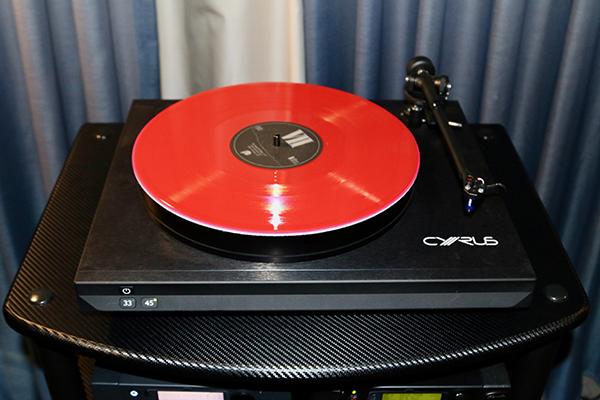
The hi-fi community — audiophiles and music lovers, mainly — had much reason to celebrate another year at AXPONA. The big show was held once again at the Renaissance Hotel and Convention Center in Schaumberg, Illinois, in the greater Chicago metro area, this time from April 12-14, 2024.
AXPONA — acronymed as a shorter way of saying “Audio Expo North America” — has grown to become the largest hi-fi show in North America. In fact, the AXPONA 2024 show set new records for attendance with 10,391 attendees who came from 42 states and 31 countries, according to post-show figures provided by AXPONA.
There were also more kids at this show than ever before — actual kids, as in school-aged, pre-collegiate kids — and they were interested in the music, as well as in the equipment reproducing it. “This year, our Gen Z pass doubled,” AXPONA Show Director Liz Smith told me via email. “It was exciting to see so many attendees ages 15-26 discovering the world of high-performance audio.” That’s certainly good news for the future of our industry!
As per usual, I was tasked by AP editor Mike Mettler to do as complete a show report as I could muster, so herewith is Part 1 of my analog-related AXPONA highlights, which includes some very important new turntable introductions and updates alike — and there were turntables almost everywhere you turned! (All photos here in Part 1 are by the author.)
SOTA
I caught up with Christan Griego, SOTA’s lead designer, who told me more. Considering the company’s success with belt-driven turntables, why design a direct-drive model? “‘SOTA’ stands for ‘State of the Art,’ so we want to keep pushing forward,” Griego replied. In this case, that means new software for their Orion Emerald drive-control system, perhaps the most exciting aspect of which is an uptick in speed-control accuracy. Continued Griego, “The read head reads 350k lines per revolution. The read head reads that and puts it into the software, so we can understand how to control it so it never deviates from 33.333.”
It seems to eliminate many of the issues that were problematic in old-school direct-drive tables, such as motor cogging. The motor is a non-cogging design, a thin-gap LSI 75 that has three torque bands. “We have a constant torque band, which is always set. Then we adjust for any deviation or anything it needs to; it’s adjusting at such a micro level. . . . We’re not doing tenths of seconds; we’re doing thousandths of a second.”
Users can fine-tune with adjustments that get made in the second torque curve region via their “Ambiance Adjustment” feature that modifies control loop behavior in 20 steps, ranging from warm/smooth to detailed/analytical. Differences are subtle — yet audible — on familiar cuts. Wow and flutter gets reduced to a bare minimum — to around 0.0028(!), according to Griego. Each table is unique, and therefore bears its own wow and flutter spec, and each customer will get a copy of their own table’s curve from SOTA.
Even a listen to “Shadrach,” from Beastie Boys’ July 1989 Capitol LP, Paul’s Boutique — one of Griego’s own LPs — sounded at least as good as I’ve ever heard this release on my home system. The funky rhythms and samples in perfect time, sharp attacks, and tonal accuracy (which I also heard on other albums’ tracks that were played) showed off the SOTA table’s precise timing prowess. (Apparently, music is never far from Griego’s mind. In addition to his Director of Development job at SOTA, he also designs trumpets and trombones, and works with orchestral trombonists.)
By audiophile-grade turntable standards, the Orion Emerald could be considered moderately priced — though it is in the upper-tier among SOTA’s offerings. Like many of SOTA’s other products, the “good, better, best” pricing structure starts at $22,500 for the base model without vacuum, tonearm, or cartridge. A top-tier Diamond model is expected to come out in Q4 of 2024, followed by a mid-level Ruby table in Q1 of 2025.
The divots, or “holes,” in the 6061 aluminum plinth are designed to create a scattergram where no single frequency can travel through that plinth. Griego said the Orion Emerald is the first SOTA table ever to have multiple tonearms as well as being able to accommodate 12in arms. The demo unit deployed an Alphason HR-200S Reference tonearm from the UK, marking the maker’s re-entry into the U.S. market for the first time in 25 years. A Hana Umami Blue cartridge completed the setup. The SOTA demo system also included Doshi tube amplification (line-stage preamp and stereo amp), a Doshi phono preamp, KEF Reference 3 speakers with two REL S/510 subs, and cabling from the Cardas Clear Beyond line.
SOTA displayed their broader lineup passively in the Expo Hall in the Convention Center side of the venue. I noticed a few unexpected accessories among their turntables, such as wooden cutting boards comprised of combinations and patterns of different wood types. “We decided to do something beautiful with the scraps of wood,” SOTA rep Alison Palmer told me. I would add that it also makes good use of extra materials rather than wasting them.
LENCO
Meanwhile, a direct-drive Lenco L-3810 turntable ($499; shown above) outfitted with an Audio-Technica AT-3600 cart and built-in MM phono preamp is set to arrive at retail within a matter of weeks. The L-3810 comes in gray or white finishes.
CYRUS AUDIO
The TTP comes with a decoupled DC synchronous motor that gets digitally synthesized to assist with speed-control accuracy and low wow and flutter, the latter of which is said to be spec’ed at “below 0.1%,” as Managing Director Nicholas Clarke told me.
The plinth is made of machined solid aluminum, with part of the front panel removed to insert power on/off and speed-control buttons, then reconjoined and finished (anodized) after. The TTP is manufactured in Germany by “by a very skilled vertically integrated company,” Clarke said in a follow-up email. (That’ll keep us wondering. . .)
The TTP table offers configurable options for feet, tonearm, power supply, and — of course — cartridge. Its feet can be switched out with aftermarket feet if desired. A PSX-R2 outboard power supply upgrade is available for $1,300.
The Cyrus TTP was demo’ed with an Ortofon Blue cartridge with the signal going to an older Cyrus Phono Signature phono preamp that’s recently been superseded by the Cyrus Classic phono preamp that retails for $2,600 — the same price as the prior model. The TTP ships with the tonearm, but without the cartridge.
AMG
A solid piece of cherry wood is bolted directly to the bottom of the plinth to couple with it, Fajen explained. The wood plinth extends underneath the platter. Vibrations dissipate better when traveling through different masses and materials. “It’s not a ‘night and day’ change, but a little more than just a visual upgrade,” he added. “It’s not as dramatic as a cartridge or tonearm change.” Though its form factor is attractive with or without the new wood skirt, it does really change the Giro’s look.
The cherry wood, which is sustainably sourced from AMG’s local collaborator Die Möbelmacher, is reported to add 20% more mass to the design and “improved energy damping characteristics,” according to the company.
The demo Giro MK II Wood’s two tonearms were the AMG 9W2 (included in the Wood’s SRP that follows below) with a Benz Micro REF-S cartridge, and a Japanese-made Viv Laboratory Rigid Float CB 9in tonearm ($6,500). An AMG Viella Turbo with AMG 12JT tonearm and oiled cherry wood skirt ($23,000) was also being played.
The Giro II comes with a 12V wall-wart power supply, but an upgraded linear power supply is available for $1,200. The Giro MK II Wood’s SRP is $10,500, with an option for customers to add either of AMG’s two tonearm models at package pricing and a limited-time preorder offer that includes select Benz Micro carts at no extra charge. Shipping is expected to start in May.
Aesthetix Audio Corporation supplied amplification — the Rhea Signature phono preamp ($10,000), Pallene line stage ($6,500) with phono preamp, and the tube-hybrid Dione power amp ($7,500) connected to Vandersteen Treo CT speakers with Cardas Clear Beyond cabling (who also supplied the system).
A listen on the AMG Giro MK II Wood in this demo system to Nick Cave and The Bad Seeds’ “Red Right Hand,” from the April 1994 Mute LP Let Love In, showed off Cave’s signature sinister growling in realistic fashion. “Inspiracion,” a track from Calexico’s Spiritoso live album from 2013 on City Slang/Anti-, also provided an equally pleasing sense of both snap and smoothness. In a departure from standard audiophile fare, the Sierra Sound/AMG/Aesthetix room later became a “metal zone,” in that they played much metal music from 5:30 p.m. until the close of show on both Friday and Saturday night.
BRINKMANN
The Brinkmann TraNt borrows some technology from the maker’s upper-end RoNt III power supply. Although the TraNt can serve as a power-supply upgrade for any Brinkmann turntable, it was primarily designed to enhance the performance of Brinkmann’s Bardo and Taurus direct-drive turntables. The latter ($28,450 as configured, and shown above) was on demo in the Dynaudio room (Utopia D) with their 12.1 tonearm and Pi phono cartridge, an MC cartridge with an aluminum body.
The demo system consisted of an Octave HP 700 SE tube preamp ($24,450 as configured) that included an RIAA phono preamp and IN 6 MC step-up transformer, and a pair of new Octave MRE 220 SE monoblock amps ($28,500/pr) powering a pair of Dynaudio Confidence 60 loudspeakers ($50,000/pr).
Dr. Matthias Lück, co-owner of Brinkmann, played a couple of tracks from two LPs on the analog-focused LowSwing label, including a new album from FINK that was made in association with Brinkmann and co-produced by Lück. LowSwing is named for (and based in) Guy Sternberg’s studio in Berlin, where material is recorded and mixed to analog tape, and then cut directly to vinyl. No computers and AD/DA conversion are used in the process, according to their site.
Lück cued up FINK’s mellower rendition of David Bowie’s classic Let’s Dance opener “Modern Love” on the Brinkmann Taurus table. The system completely got out of the music’s way. Tonal purity and neutrality, values closely associated with pro-audio production, were maintained through playback on the demo system. Next, Lück played “Killer,” a track from Reema’s The LowSwing Sessions that sounded, well, pretty killer. Every bit of delicacy and subtlety of her gentle guitar strumming seemed to come through in this intimate recording. This was fine listening — and an experience that drew me much closer to the music than expected in such a large room and system.
MONARCH
Monarch’s co-owners Jon Baker and Rich Maez have been around the audio block, and they like to do things differently. Last year at AXPONA, they had a tropical theme, and this year, vintage Italian racing memorabilia set their room apart. They also had passive and active displays, plus cable debuts from Siltech. Their active demo system included a Boulder 1008 phono preamp ($16,800; shown below), and a B.audio B.dpr One EX streaming preamp and B.audio Reference mono amps ($34,400) ahead of Audio Physic Codex speakers ($20,500).
Another aspect of this room that was much appreciated was that the Monarch guys play atypical show music — and have been known to even refuse to play some of the same ol’ audiophile staples such as Diana Krall, Rebecca Pigeon, and Nils Lofgren. Maez played a rare 1982 Mute Records 12-inch single (remember those?) of Yazoo’s “Only You,” with an extended version of “Situation” on the B side. (The band’s name was shortened to Yaz here in North America.) It also seemed like the right place to break out my copy of Industrial/EDM oddball Meat Beat Manifesto’s February 1989 LP Storm the Studio on Wax Trax, a significant but sadly now defunct Chicago label. This system showed its solid production quality and heavy beats. You can tell it was meant to be played loudly. Big fun!
REGA
It may seem an odd — as in, high-low — pairing, but the sound on both my own Bonny Light Horseman LP and one from Muireann Bradley they had on hand was surprisingly expansive, belying those stand-mounted speakers’ diminutive size. Even mid-bass came through more fully than it had any right to.
MUSIC HALL
And that’s it for Part 1! Stay tuned for Part 2 of my AXPONA 2024 report, which will be posting here soon.
Author bio: Julie Mullins, a lifelong music lover and audiophile by osmosis who grew up listening to her father’s hi-fi gear, is also a contributing editor and reviewer on our sister site, Stereophile, for whom she also writes the monthly Re-Tales column. A former fulltime staffer at Cincinnati’s long-running alt-weekly CityBeat, she hosts a weekly radio show on WAIF called On the Pulse.
If you’d like to see even more of our AXPONA coverage, check out Ken Micallef’s turntable-centric video report here, Mike Mettler’s look at Luxman’s new PD-191A turntable and E-07 phono preamp and his review of the Acoustic Sounds Atlantic 75 vinyl listening session here, and Mettler’s Day 1 photo essay here.
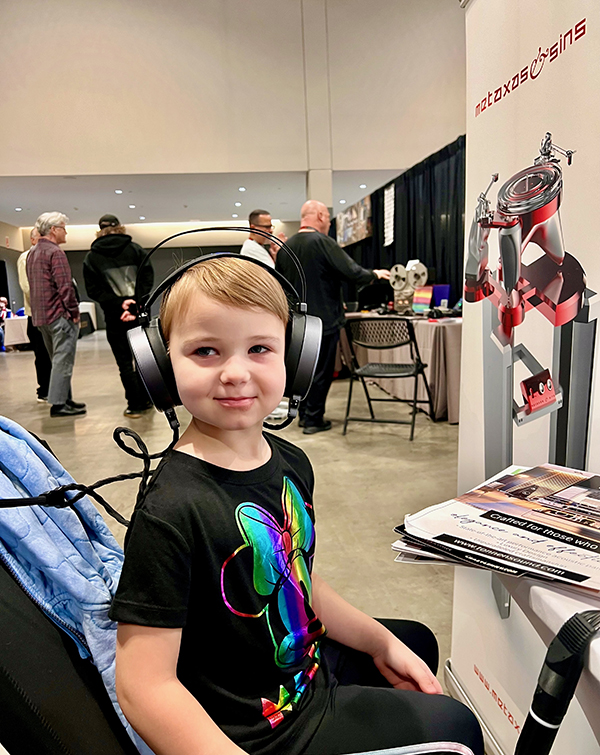
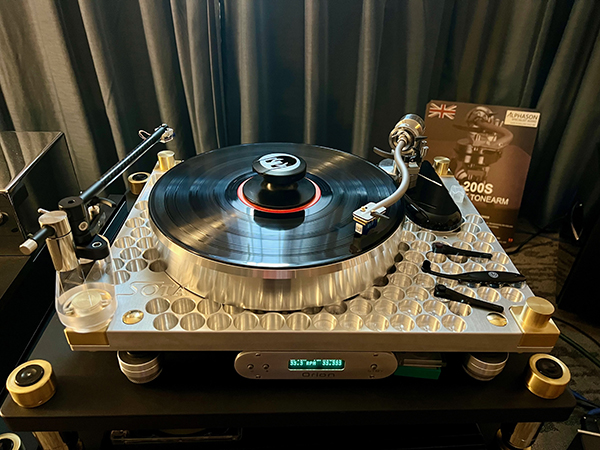
It seems fitting to start with a few debuts. As I noted in Part 1 of last year’s AXPONA report, SOTA is based in Delavan, Wisconsin, and the company manufactures several models of belt-driven turntables, along with speed controllers and other analog wares. Now, SOTA has launched a new direct-drive turntable — their first — called the Orion Emerald.

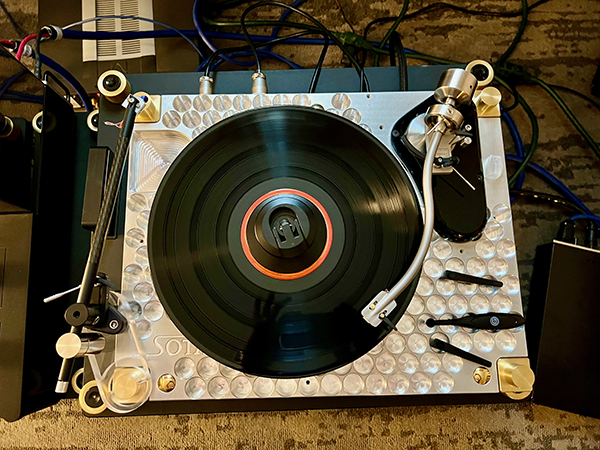
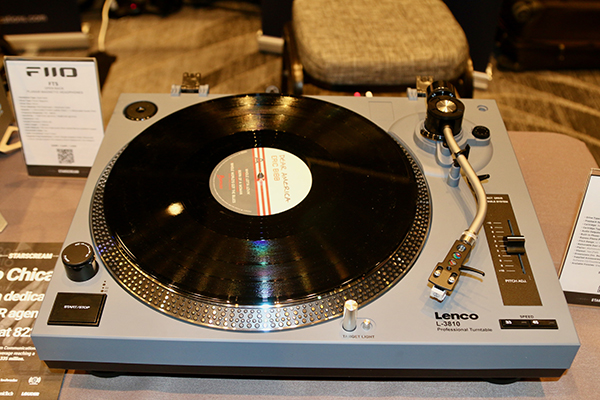
Another brand with UK origins that recently returned to the U.S. market happens to be Lenco. A local Chicago PR division of Starscream Communications showed some Lenco products on passive display, including the 345 “professional” turntable ($849). It comes complete with a carbon-fiber tonearm fitted with an Ortofon Red cartridge and built-in moving-magnet phono preamp, for easy pairing with active speakers.
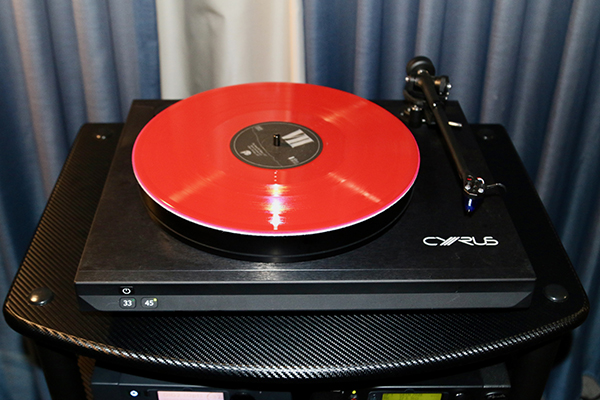
News from yet another English company: Cambridgeshire, England’s Cyrus Audio recently introduced their first-ever turntable, the TTP — a.k.a., the TurnTable Player ($5,800) — as part of the company’s 40th anniversary program for this year. They’ve long made phono preamps and other electronics, and they decided to finally produce a turntable. The TTP weighs nearly 25kg, so its design adheres to a high-mass approach. The belt-drive design uses a square belt that avoids some of the issues found in typical rounded belts — it can self-align, it’s said not to ride up or down, and it can untwist itself. The square belt also lacks the discontinuity of a connection point found in round belts.

A German manufacturer, AMG — which stands for Audio Manufactur Germany —
presented a U.S. debut of a new version of their aptly named Giro MK II turntable: the Giro MK II Wood turntable ($13,500, with AMG 9W2 tonearm). The essential difference is, this newer MK II Wood model has a skirt of cherry wood that — besides its aesthetic enhancement — serves as a subchassis. Distributor Michael Fajen of Sierra Sound — a first-time AXPONA exhibitor — explained that there are two main reasons for the update: 1) adding a different and attractive material, and 2) extra mass.
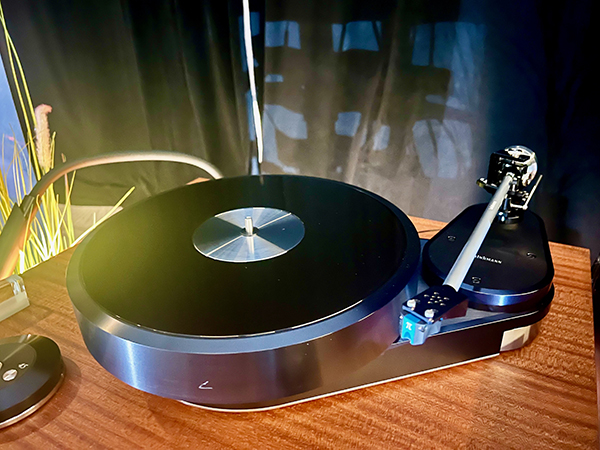
Brinkmann, another German manufacturer, introduced a couple of new products — the new TraNt power supply ($3,490) for their turntables, and a limited-run reintroduction of the company’s Pi phono cartridge ($4,490), only 50 of which will be created. Benz-Micro serves as OEM, providing coil assemblies and production services for what is otherwise a uniquely Brinkmann cartridge, noted Brinkmann’s Director of Sales and Marketing Anthony Chiarella.


Another Benz cartridge — a Benz-Micro LP-S Ebony LOMC ($5,000) — turned up on an unexpected turntable rig in the Monarch room: on a loaner vintage Technics SL1200 Mk5 table (shown below) with custom modifications. Not to give away secrets, but Chad Stelly provided a few details on his modded turntable. Some of those mods included a Jelco TK 850 S tonearm (which is no longer made), machining to accommodate a larger gel record mat, upgrades to the stock spindle bearing, and electronic drive system upgrades from KAB USA, for which Stelly has his own implementations.
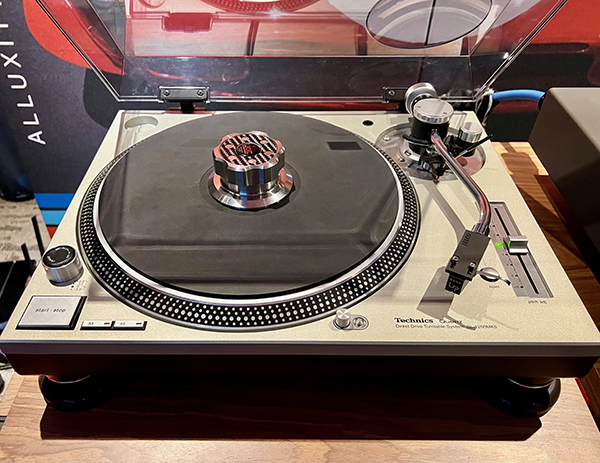
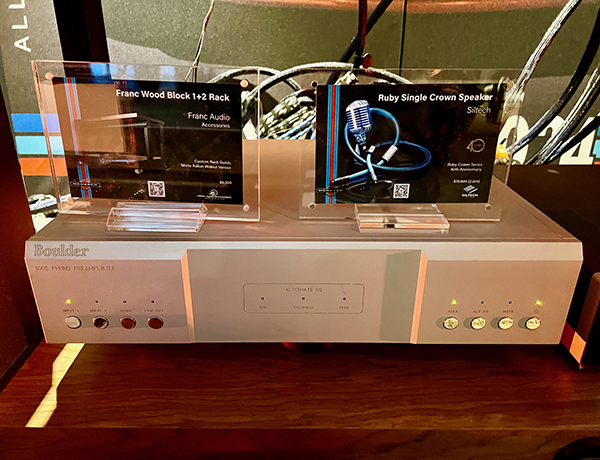
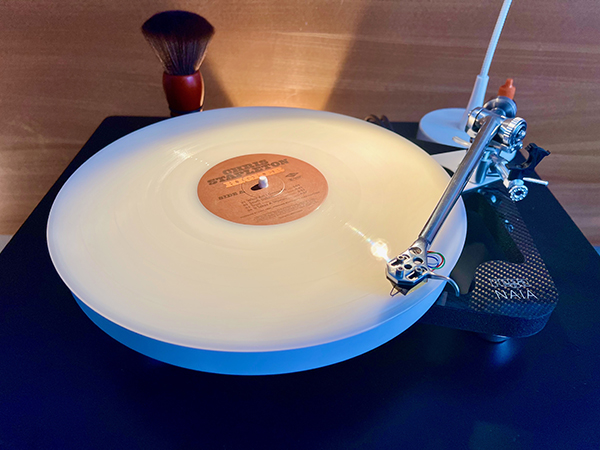
The Sound Organisation presented the new top-of-line Rega Naia turntable with Aphelion 2 cartridge ($16,995), whose signal went to a Rega Reference Aura MC phono preamp ($6,695) ahead of a Chord Electronics Ultima integrated amp ($11,250) making its U.S. debut and driving a pair of ProAc Tablette 10 Signature loudspeakers ($3,150-$3,550), following the legacy of the late Stewart Tyler’s prior designs.
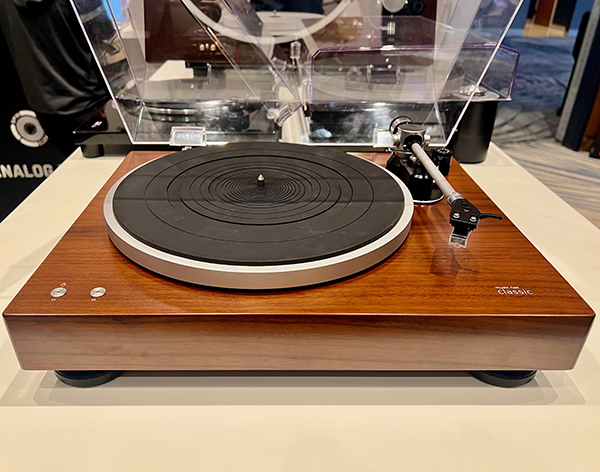
Our sister site Stereophile recently covered MoFi Distribution’s acquisition of Roy Hall’s Music Hall company. Hall, who attended AXPONA, is still consulting to ensure a smooth transition. Several Music Hall turntables — such as the Classic table seen above — were shown on passive display in a large room on the first floor.

- Log in or register to post comments


Thank you.
These posts always toggle me between "I want it," and "How much did you say?"

The plinth appears to be the same as the Millennia plinth, unpainted. How are the tonearms isolated?

Plinth is similar to my Millennia, drill pattern is a little different. Don't know what the well on the left-rear is for. LOVE the Logo machined in. They should make the Millennia with this beautiful plinth as an option. My Millennia is from 2004. ZERO issues, vacuum still works as brand new. You will not get better service from MOST turntable manufacturers. Traded in my Star III for the Nova,1991.....traded in the Nova for the Millennium, 2004 Bought a new belt in 2021, just because.
Solid investments ! William Gallassero.

Nice review, Julie.
By the way, Lenco was originally a Swiss company, not an English one.
Just like Thorens was, at the beginning.







































